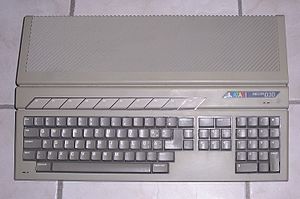Atari Falcon: Difference between revisions
Atari hardware template |
Virtualsim (talk | contribs) m a 6 stages pipeline is not "deep" by any measure. The novelty was the fact that like the i486, the 040 WAS pipelined. |
||
| Line 16: | Line 16: | ||
The Falcon's performance was not as great as it could have been, mostly due to Atari's decision to put the 32-bit [[68030]] microprocessor on a 16-bit [[data bus]]. This was in order to maintain close compatibility with the [[Atari ST]]E. [[Apple Computer]] was widely criticised for making the same kind of decision with their [[Apple Macintosh|Macintosh]] LC computer, although this was done to prevent sales of this low-end computer from cutting into the sales of the more expensive Macs. |
The Falcon's performance was not as great as it could have been, mostly due to Atari's decision to put the 32-bit [[68030]] microprocessor on a 16-bit [[data bus]]. This was in order to maintain close compatibility with the [[Atari ST]]E. [[Apple Computer]] was widely criticised for making the same kind of decision with their [[Apple Macintosh|Macintosh]] LC computer, although this was done to prevent sales of this low-end computer from cutting into the sales of the more expensive Macs. |
||
Atari created a number of prototypes of the '''Falcon040''' (based on the more capable |
Atari created a number of prototypes of the '''Falcon040''' (based on the more capable fully-[[instruction pipeline|pipelined]], integrated-[[Floating Point Unit|FPU]], [[Motorola 68040]], and using a "microbox" case), but cancelled it in order to focus developers on the ''[[Atari Jaguar]]''. |
||
Interestingly the microbox case designed by Atari looks a lot like the Sony PS2, right down to the ability to run it vertically or horizontally. It is even referenced in the PS2 patent applications.{{Fact|date=August 2007}} |
Interestingly the microbox case designed by Atari looks a lot like the Sony PS2, right down to the ability to run it vertically or horizontally. It is even referenced in the PS2 patent applications.{{Fact|date=August 2007}} |
||
Revision as of 20:13, 23 August 2007
 | |
| Type | Personal computer |
|---|---|
| Release date | 1992 |
| Discontinued | 1993 |
| Operating system | MiNT |
| CPU | Motorola 68030 @ 16 MHz |
| Memory | 1 ~ 14 Megabytes |
The Atari Falcon was Atari's final computer product, more specifically named the Atari Falcon030 Computer System. Codenamed Sparrow, the machine was based on a Motorola 68030 main CPU, and had a Motorola 56000 digital signal processor (the latter distinguishing it from most other microcomputers of the era).
The Falcon was released in late 1992 and subsequently cancelled in late 1993 as Atari restructured itself to focus completely on the release and support of its newest product, the Atari Jaguar video game console. The Atari Falcon030 had many powerful features. The use of the 1040ST case was due to haste and low cost, the planned "microbox" case that was more like the Mega STe or TT030 case wasn't ready yet and Atari had decided to exit the computer business.
The Falcon's performance was not as great as it could have been, mostly due to Atari's decision to put the 32-bit 68030 microprocessor on a 16-bit data bus. This was in order to maintain close compatibility with the Atari STE. Apple Computer was widely criticised for making the same kind of decision with their Macintosh LC computer, although this was done to prevent sales of this low-end computer from cutting into the sales of the more expensive Macs.
Atari created a number of prototypes of the Falcon040 (based on the more capable fully-pipelined, integrated-FPU, Motorola 68040, and using a "microbox" case), but cancelled it in order to focus developers on the Atari Jaguar.
Interestingly the microbox case designed by Atari looks a lot like the Sony PS2, right down to the ability to run it vertically or horizontally. It is even referenced in the PS2 patent applications.[citation needed]
Shortly after release Atari used the MiNT Operating system instead of TOS.
In 1995, the music company C-Lab bought the rights to the Falcon hardware design and began producing their own versions. The Falcon Mk I was a direct continuation of Atari's Falcon030 with TOS 4.04. The Falcon Mk II addressed a number of shortcomings in the original design, making it more suitable to use in a recording studio (these were unofficially termed 'Cubase modifications') such as accepting Line-level audio in without the need for a pre-amp or mixer. The Falcon Mk X was mounted in a 19" 1U rack case, with external keyboard and space for internal SCSI hard discs.
Specifications (Falcon030)
- Processor: Motorola 68030 at 16 MHz with 512 byte cache.
- FPU: optional Motorola 68882
- DSP: Motorola 56001 DSP chip at 32 MHz.
- Graphics: "VIDEL" video CPU.
- Audio:
- 8 stereo (16 mono) 16 bit audio DMA channels at up to 50 kHz
- SDMA sound/DMA Co-processor
- Yamaha 2149 3 Channel Audio
- Memory: 1, 4, or 14 MiB of RAM with 512 KiB ROM.
- Bus Speed: 32 MHz.
- Drives and I/O
- 2.5 inch IDE ( laptop disk ) - internal
- 1.44 MB 3.5 inch Floppy disk - internal
- External SCSI-II connector

